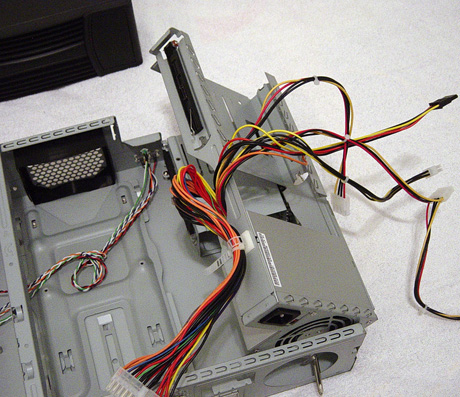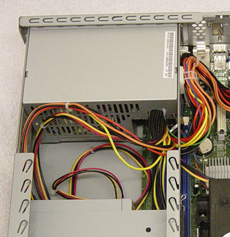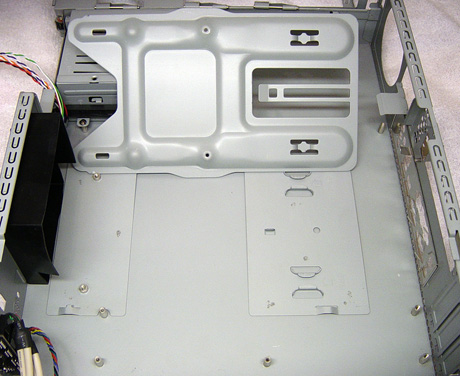Intel's Long Awaited BTX Form Factor
by Purav Sanghani on November 15, 2004 5:31 AM EST- Posted in
- Cases/Cooling/PSUs
First Look: AOpen B300 BTX case
External DesignAt first glance AOpen's B300 chassis included with Intel's evaluation kit seems like a normal half height ATX desktop case. The only thing that sets the B300 apart from ATX form factor cases of this size is the placement of the drive bays on the left side instead of the right. Still, at first glance it will seem like it's only a minor design change. We also notice there is a large section of the bezel which looks to be designed as a ventilation of some sort for an 80mm or even a 90mm fan mounted on the inside as an intake.

Click to Enlarge
At the far right of the bezel is a small door which opens to the right to expose four USB ports, audio ports, and a FireWire port.

Click to Enlarge
To remove the cover we need to remove three screws at the back of the case. We then slide the cover foreward about an inch and lift to remove it.

Click to Enlarge
Internal Design
Inside we see the drive bays at the front of the case on the left side. There is a single 5-1/4" drive bay which makes use of "optical fixing bars" to secure optical drives in place. Beneath the 5-1/4" bay is space for two 3-1/2" HDDs also utilizing the same fixing bars to secure them in place. Though AOpen implements these screw-less devices here, many screws are still used elsewhere throughout the case. Ironic, isn't it?

Click to Enlarge
To get to the 3-1/2" drive bays AOpen has designed the case in a way that this entire right section, which includes the drive bays and power supply, can be unfolded from the rest of the case out to the right. This feature helps reduce clutter when installed the motherboard as well as drives into their bays. To unfold this section there are 3 screws that need to be removed, 1 at the front and 2 at the back below the power supply. We then pull the frame forward and turn it out to the left.

Click to Enlarge
Directly behind the drive bays and mounted to the fold out frame is the FSP 275W SFF power supply with an 80mm fan. The clearance between the drive bays and the power supply is only a few inches which worried us a great deal. HDDs come in SATA interfaces but most all optical drives have an IDE interface right now. Combined with the power supply's cabling, things will definitely become claustrophobic.
 Click to Enlarge |
 Click to Enlarge |
The entire section to the right of the fold out tray will be taken up by the BTX motherboard. We noticed a metal plate on the motherboard tray called the Support Retention Module which can be removed.

Click to Enlarge
According to Intel this plate will provide extra support for the motherboard and retention for the thermal module due to the weight of the heatsink. The motherboard tray itself is made up of this entire section. Again AOpen has simplified things by using stand-offs for the outer edges of the motherboard while supporting the middle sections of the D915GMH with the retention module.










77 Comments
View All Comments
trikster2 - Tuesday, November 16, 2004 - link
I've got to say, this review is bad, even by anandtech standards.
Comparing an mBTX destop to a mATX TOWER to a Fullsize ATX desktop, litteraly comparing apples to oranges to pears, and then coming to sweeping conclusions like "any of us were skeptical for a long time, but after seeing the numbers ... we can conclude that BTX is not hype. " is simply ludicrouse.
Shame on you anand for letting such a review fall through your QC into the hands of the general public.
I'm not sure if you guys are incompetent or payed by intel to find a combo to pimp the BTX standard. I just did a refresh 5 times, no intel adds so it must be the former.
How about spending 49.95 on a decent desktop mATX case and compare apples to apples, instead of just grabbing whatever was laying around the lab (we've seen that whacked oppus case in other reviews haven't we?)?
I have the silverstonetek equivalent of the oppus matx tower. It is the worst mATX cases I have ever worked with. Give us a break and do a valid review, mATX single fan 1/2 height desktop to mBTX single fan 1/2 height desktop.
johnsonx - Tuesday, November 16, 2004 - link
I see nothing here in the BTX standard that couldn't have been better accomplished with a backwards and forwards compatible ATX II standard.ATX II compliant motherboards would have standardized locations for the CPU socket, two standard locatations for RAM (either or both locations could be used, as needed), standard locations for the power connectors, standard locations for the most common onboard ports (IDE, SATA, front USB, audio, etc.) and standard component heights (capacitors and etc.).
ATX II compliant cases would have standardized air intake and exhaust locations, fan mounts, and ducting. ATX II cases could be built to open from the right side, with the CPU on the bottom. The ducting would be removeable for use with a legacy ATX mainboard.
ATX II compliant heatsinks would be fanless, designed to be cooled by an ATX II chassis duct, but would have a fan mounting point for use in a legacy ATX chassis. Boxed coolers that come with retail CPU's would include the fan on a standard clip with instructions to remove it when used with an ATX II compliant chassis and mainboard.
ATX II compliant power supplies would basically be the same as the latest ATX supplies are now - 24pin power, 8-pin ATX 12v power, standard 4-pin drive power plugs, SATA power plugs, PCI-E graphics power plug. 24 to 20 pin converters and 8-pin to 4-pin converters would be standard with retail power supplies.
Any mix of ATX and ATX II components would work fine together, but a system built of all ATX II components would gain various cooling, noise level, assembly and operational advantages.
What does BTX offer that my hypothetical ATX II standard doesn't? Oh, yeah... ATX II couldn't give you a face of hot air...
xsilver - Monday, November 15, 2004 - link
To the guy b4 that was wondering where the air intakes are -- no amount of case fans are going to create a vacum inside your case, there's just not enough pressure -- unless you tape up all the gaps lol.... so the air will just "flow" in from any holes in your caseblackmetalegg - Monday, November 15, 2004 - link
Bah we're(work) using this motherboard in an application that shall remain anonymous(NOT oridinary PC) and the damn design make wiring a bitch to deal with. And the motherboard isn't all that stable, considering it's from Intel...justly - Monday, November 15, 2004 - link
BTW that 20.666715 "cfm" is assuming all of the area taken by the 2 fans has air flow, but we should all knoe that the motor and frame ocupy some of that space so the actual "cfm" would be lower.justly - Monday, November 15, 2004 - link
Why was "lfm" not converted to "cfm" for a direct comparison on page 11?If I am reading this correctly the BTX provides 40 "cfm" while the ATX requires 150 "lfm". This sounds like BTX is an overwhelming success, untill you do the conversion that is. So what exactly does this 150 "lfm mean in comparison, well if the ATX uses 2-80mm fans that would be 80mm x 80mm = 6400 square mm per fan, 6400 x 2 = 12800 square mm for both fans, convert that to square ft and you get 0.1377781 square ft, take that and multiply by the 150 "lfm" and we get (drum roll) 20.666715 "cfm". Thats right about half what the BTX has.
I don't know if this was intentional or not, but I will give the author the benifit of the doubt and assume it was not.
If I have overlooked something please explain my mistake, if not then I feel some injustice has been done to the readers that did not ask this question.
ShadowVlican - Monday, November 15, 2004 - link
like someone else said... the BTX form wasn't made for enthusiasts, since we already know how to cool our rigs properly..BTX is for the average consumer who doesn't know jack about computers, so BTX will help those people have quieter/cooler computers without them reading forums/articles
i'm just wondering how well the transition from ATX machines into BTX will go...
ZobarStyl - Monday, November 15, 2004 - link
Yes Five40, you can't directly upgrade from 754 to 939, but you can take your case and PSU with you...I'm using the same case I used in my AXP system now for an A64 with watercooling, but if Intel has their way, my next rig won't be able to use the same rig and I'll just have to spend more cash. Hence, we are rightfully pissed because the real question is "Why?" and when something lacks benefits but costs you mad cash: a whole new case and good PSU will set me back 120 bucks, for what? Nothing worth my time.MAValpha - Monday, November 15, 2004 - link
Anyone know how pBTX stacks up against FlexATX?five40 - Monday, November 15, 2004 - link
#50....umm I can't do a A64 to A64 upgrade so what's your point? 754 to 939 does me no good. I just see this as another socket update. A64 might not need it right now, but if all things where just made for what we need right now, we'll move forward at a very slow pace.